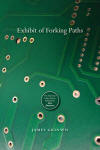Exhibit of Forking Paths
It is impossible to think of forking paths without recalling Borges’s garden of innumerable possibilities. And so in James Grinwis’s second book of poems, Exhibit of Forking Paths, selected by Eleni Sikelianos for the National Poetry Series, it makes sense that we find a poetry of possibilities and alternatives, a bit of play, an interest in “what the sounds mean before the definitions of sounds,” and a space where things can simultaneously be and not be. The title poem, which opens the book, presents different lives captured on numbered tablets, with the speaker coyly stating, “In the case of tablet 31, we will not speak.” Grinwis delivers a lot in this collection, but he reminds us we cannot have it all.
It is impossible to think of forking paths without recalling Borges’s garden of innumerable possibilities. And so in James Grinwis’s second book of poems, Exhibit of Forking Paths, selected by Eleni Sikelianos for the National Poetry Series, it makes sense that we find a poetry of possibilities and alternatives, a bit of play, an interest in “what the sounds mean before the definitions of sounds,” and a space where things can simultaneously be and not be. The title poem, which opens the book, presents different lives captured on numbered tablets, with the speaker coyly stating, “In the case of tablet 31, we will not speak.” Grinwis delivers a lot in this collection, but he reminds us we cannot have it all.
Throughout the book, there are many poems titled after electrical circuits that then begin with a diagram of the title circuit. In each case what follows is a prose poem that somehow springs from the shape of the diagram, as in “Capacitor” ( —| |— ):
On the way to the store a delivery truck collided into a wall, behind which a group of men were throwing javelins, many of which had thocked into the truck-rammed wall with the violence spilling out of the throwers’ hearts.
So the shape simultaneously explains the capacitor and, on another path, a truck and javelins rushing forth from opposite directions into a wall. In “NPN Transistor,” a boy thrashes around in a region of meditation, “[a] state of confusion, very lost and unusually shaped.” The circuitry pieces are imaginative and fun in their descriptions, which frequently use non-sequitur and neo-surrealist imagery, similar to other poets who have, like Grinwis, spent time in Western Massachusetts, such as Heather Christle and Eric Baus.
In addition to the circuitry poems, the book contains lyric poems that also play with alternate possibilities through lists and repetitions, such as in “Bird Sculptures 3,” which lists titles for various sculptures, including:
Half-Bird Half-Dromedary
Bird Flash Unit
Thinking Bird
Circuit of Clothes Bird
Bird with Sponge for Face
Bird Made of 3 Twisted Leaves
While the lyric poems share many of the same qualities as the prose pieces, the constraint of the line, tightly controlled language, and use of fragments make these poems stand out in the collection. The third section of “Climograph” concludes:
The beyond goes only as far
as ourselves, she said.
The ocean seemed pummeled
with girls’ fists.
A general understanding of earth
made the windows of the apartment
glow and radiate a series of hums.
To be a wind funnel bent.
A cup of something strong
on the desk of an innocent.
A downpour caught
in a carton of flowers.
Overall the collection is full of stunning and sometimes eerie images that will last long after the book is closed, like phantoms, “fragile, grounded,” who need to be cared for (“Of Phantoms”).





